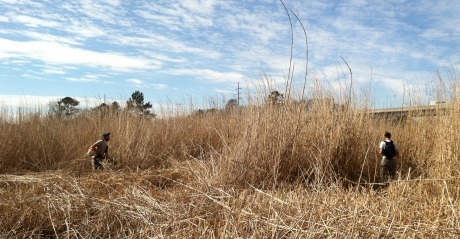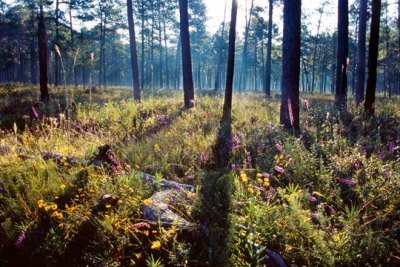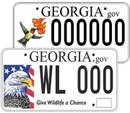
New coastal network targets alien invaders
CISMA may sound like an alien species, but the acronym refers to an effective approach in combating exotic plants and animals that threaten ecosystems. And it’s an approach taking shape on Georgia’s coast.
Representatives of more than 40 organizations met last month to launch the Coastal Georgia Cooperative Invasive Species Management Area. The goal: Conserve the region's native wildlife and habitats through a collaborative effort to prevent or control invasive species on public and private lands in 11 counties.
Georgia Department of Natural Resources botanist Eamonn Leonard, who coordinated the meeting, said the cooperative is aimed at focusing efforts and filling gaps in the war on exotic aliens like Chinese tallow tree, the giant reed phragmites ( pictured) and feral hogs, species that can reshape landscapes and displace native wildlife. “What are the gaps, what are we doing and how do we work as a cooperative to fill those gaps,” said Leonard.
Purdue University’s Kate Howe, coordinator of the Midwest Invasive Plant Network, helped with the March 15 workshop in Richmond Hill. Howe said the key benefit of cooperatives is seeing landscapes as a whole. “You can get rid of all the privet on your property. But if your neighbor has it, you just keep getting it. If you look across the landscape as a whole, you’re much more likely to have success.”
CISMAs also provide a structure for detecting invasive species early, raising public awareness, training staff and acquiring grants. Challenges include getting organized and staying energized.
Leonard, who works with DNR's Nongame Conservation Section, considers the coastal CISMA critical.
“Just from the planning meeting … it has really short-circuited a lot of isolated efforts to figure out what is the best method" to control a species, he said.
A steering committee will meet in May to chart the group’s future. Partners have already coordinated a water hyacinth pull for later this month ( email eamonn.leonard@dnr.state.ga.us to volunteer) and an Invasive Species Workshop at Skidaway Island State Park on June 14 ( more at www.gaeppc.org).
Read the full announcement about the Coastal Georgia Cooperative Invasive Species Management Area!
Inside track on invasives
 Out my backdoor
Fascinating flycatchers
By Terry W. Johnson
On a recent cool April morning, I was greeted with a chorus of bird songs from some familiar year-round residents. Then I heard a call I hadn’t heard this year. From the back of my lot came a loud wheep.
This robin-sized flycatcher is more often heard than seen. But it is truly a striking bird, with its bright sulphur belly and – best seen through binoculars – rufous tail and wingtips.
The great crested flycatcher is also a fascinating cavity-nester. Pairs build bulky nests of typical materials such as twigs, leaves and hair, yet they also weave in bits of rope, plastic and even shed snakeskins!
Great crested flycatchers hunt from a perch, eating everything from mosquitoes to beetles, butterflies, moths, katydids, grasshoppers, spiders and even small lizards. The most bazaar item I saw a pair nesting near my office bring back was one of the largest spiders I have ever seen (pictured).
Isn’t it amazing what we can see just outside our backdoor?
For more amazing insights into great crested flycatchers, check out Terry’s complete column.
Terry Johnson is a former Nongame program manager with Wildlife Resources and executive director of TERN, the Nongame Conservation Section’s friends group.
|

Program promising for gopher tortoises
Georgia landowners must apply by April 30
Georgia’s state reptile will receive some much needed help from a federal Farm Bill program. But interested landowners have only until April 30 to apply for financial assistance through the new Working Lands for Wildlife partnership.
The teamwork pairs the Agricultural Department’s Natural Resources Conservation Service and the U.S. Fish and Wildlife Service in a conservation effort to restore populations of at-risk species and strengthen rural economies.
The program in Georgia will involve restoring and protecting gopher tortoises and their habitat in south Georgia, and to a lesser extent – because of limited habitat on private land – the golden-winged warbler in north Georgia.
Nongame Conservation Section Chief Mike Harris of Georgia DNR welcomed the new partnership. Referring to gopher tortoises, Harris said he’s “excited about the opportunity to focus Farm Bill programs on a species of concern that also benefits other wildlife.”
Threatened by habitat loss, these large land turtles are state-listed as threatened and a candidate for federal protection in Georgia and the rest of their eastern range. (They are already federally listed in Mississippi, Louisiana and western Alabama.)
Working Lands for Wildlife will help private landowners in Georgia create, manage and maintain pine savanna habitat for breeding populations of gopher tortoises. The primary practices will be planting longleaf pine, conducting prescribed burns and removing mid-story hardwoods.

Saving pine savannas and tortoises
-
Longleaf pine forest, one of the world's most biologically diverse ecosystems, provides critical habitat for gopher tortoises and other imperiled species.
-
The gopher tortoise is a keystone species and indicator of longleaf pine ecosystem health.
-
Gopher tortoises depend on deep, well-drained soils and an open understory. In turn, their burrows provide vital shelter for many at-risk species. Gopher tortoises also help disperse plant seeds.
-
Habitat destruction, degradation and human predation have greatly reduced gopher tortoise populations. More than 90 million acres of the U.S. Southeast was once covered by longleaf pine savanna. About 3.4 million acres remain today.
-
More than 80 percent of gopher tortoise habitat is in private or corporate ownership.
Source: Natural Resources Conservation Service
Noteworthy
It’s guaranteed that the grand prize winner of the 2012 Youth Birding Competition T-shirt Art Contest will be stunning. Announced at the Youth Birding Competition banquet April 28, the blue ribbon will go to one of four wonderful winners chosen by age category: the red-tailed hawk by Daniel Ng of Duluth (preK-second grade category); ruby-throated hummingbird by Catherine Shih of Alpharetta (third-fifth grade); blue jay by Qianci Ma, Duluth (sixth-eighth grade) or the eastern screech owl by Gabriela Delacruz of Atlanta (high school). The art contest fielded a record 264 entries. ( Winners are featured in this issue's masthead.)
The Altamaha shiner was found on the Yellow River downstream of Porterdale Dam during a fish and mollusk survey led by DNR. The discovery marked a new occurrence in the watershed for this species listed as state threatened and petitioned for federal protection.
Bat research at Sapelo and Little St. Simons islands is off to a flying start. Working with University of Georgia student and former DNR intern Craig Bland, current Nongame Conservation Section bat interns Jackie Jeffrey and Bronson Curry recently caught their first northern yellow bat on Little St. Simons. The two-year project is focused on exploring the species' abundance and roosting and foraging preferences.
The Georgia Mountain BirdFest returns to Unicoi State Park & Lodge May 4-6. More than 60 field trips, guided hikes and hands-on activities are open to birders of all ages and skills. Registration ends April 23.
McDuffie Environmental Education Center has some new and much needed digs. After operating for years out of "retired" mobile classroom trailers, which had rapidly deteriorated, the center opened a new classroom with ADA access, discovery room, restrooms and office space for educators last month at McDuffie Public Fishing Area near Thomson.
Drought put a damper on egg collecting for gopher frog restoration at The Nature Conservancy’s Williams Bluff Preserve in Early County. The lack of water in isolated wetlands undercut amphibian breeding, and Nongame Conservation Section senior biologist John Jensen collected only three egg masses from the gopher frog donor pond at Fall Line Sandhills Wildlife Management Area. Partners will raise most of the eggs to metamorphs, or froglets, for release this summer at Williams Bluff. ( See also “Wetland powers frog, newt projects,” May 2011.)
Changes to Georgia’s conservation tax credits are outlined in this article by Kevin McGorty, director of Tall Timbers Land Conservancy. McGorty highlights how lawmakers in the 2012 General Assembly tightened the Tax Credit Program that has protected more than 116,000 acres since 2007.
At least half of two new peregrine pairs in Atlanta are natives. The males of both pairs – one has a confirmed nest near Perimeter Mall – were banded as nestlings at SunTrust Plaza nest earlier this decade.
Rayonier donated approximately 7,000 longleaf pines that will be planted in tornado salvage areas at Hard Labor Creek State Park, near Rutledge.
Headlines
Parting shot

George Washington Carver High School students and visitors
learned about Georgia's rare fish and carnivorous plants as DNR
senior aquatic zoologist Brett Albanese and botanist Lisa Kruse (pictured)
staffed a Nongame Conservation Section display at the Atlanta school’s
Environmental Day April 14. Outreach is a significant part of Wildlife Resources
Division efforts to raise awareness about wildlife conservation.
Credits
** Masthead: Collage of Youth Birding Competition winning T-shirt Art Contest entries: eastern screech owl/Gabriela Delacruz; blue jay/Qianci Ma; red-tailed hawk/Daniel Ng; ruby-throated hummingbird/Catherine Shih. Photos by Linda May/Ga. DNR
** Cutting down phragmites, an invasive reed, in August 2011 near Interstate 95. Ga. DNR
** Great crested flycatcher with large spider. Terry W. Johnson
** Gopher tortoise near burrow. John Jensen/Ga. DNR
** Longleaf pine forest in southwest Georgia. Marc Del Santro
** Lisa Kruse shows a girl pitcherplants at Carver High. Catrina Dillard

Give wildlife a chance!
The Nongame
Conservation Section of Georgia DNR receives no state funds to
conserve nongame wildlife, native plants and natural habitats. Instead, we
depend on contributions, grants and fundraisers, such as the eagle and
hummingbird license plates.
How can you help?
Georgia Wild is free, sent twice monthly and focused on rare, endangered and other nongame wildlife.
Nongame includes wildlife not legally fished for or hunted, plus native plants and natural habitats.
Georgia Wild © 2012. Wildlife Resources Division Nongame Conservation Section. All rights reserved.
|